
Security News
Maven Central Adds Sigstore Signature Validation
Maven Central now validates Sigstore signatures, making it easier for developers to verify the provenance of Java packages.
A zero-boilerplate canvas drawing framework for Python 3, based on Pygame.
Here's some neat stuff you can do:
# import all
from drawzero import *
# simple shapes
fill('#12bbae')
line('red', (400, 400), (800, 800))
circle('yellow', (500, 560), 200)
filled_circle('brown', (500, 500), 20)
text('red', 'Hello, world!', (300, 200), 72)
rect('blue', (200, 600), 100, 100)
filled_rect('orange', (400, 600), 100, 100)
polygon('white', [(20, 200), (100, 240), (40, 160)])
filled_polygon('burlywood', 200, 400, 130, 304, 20, 342, 20, 458, 130, 496, )
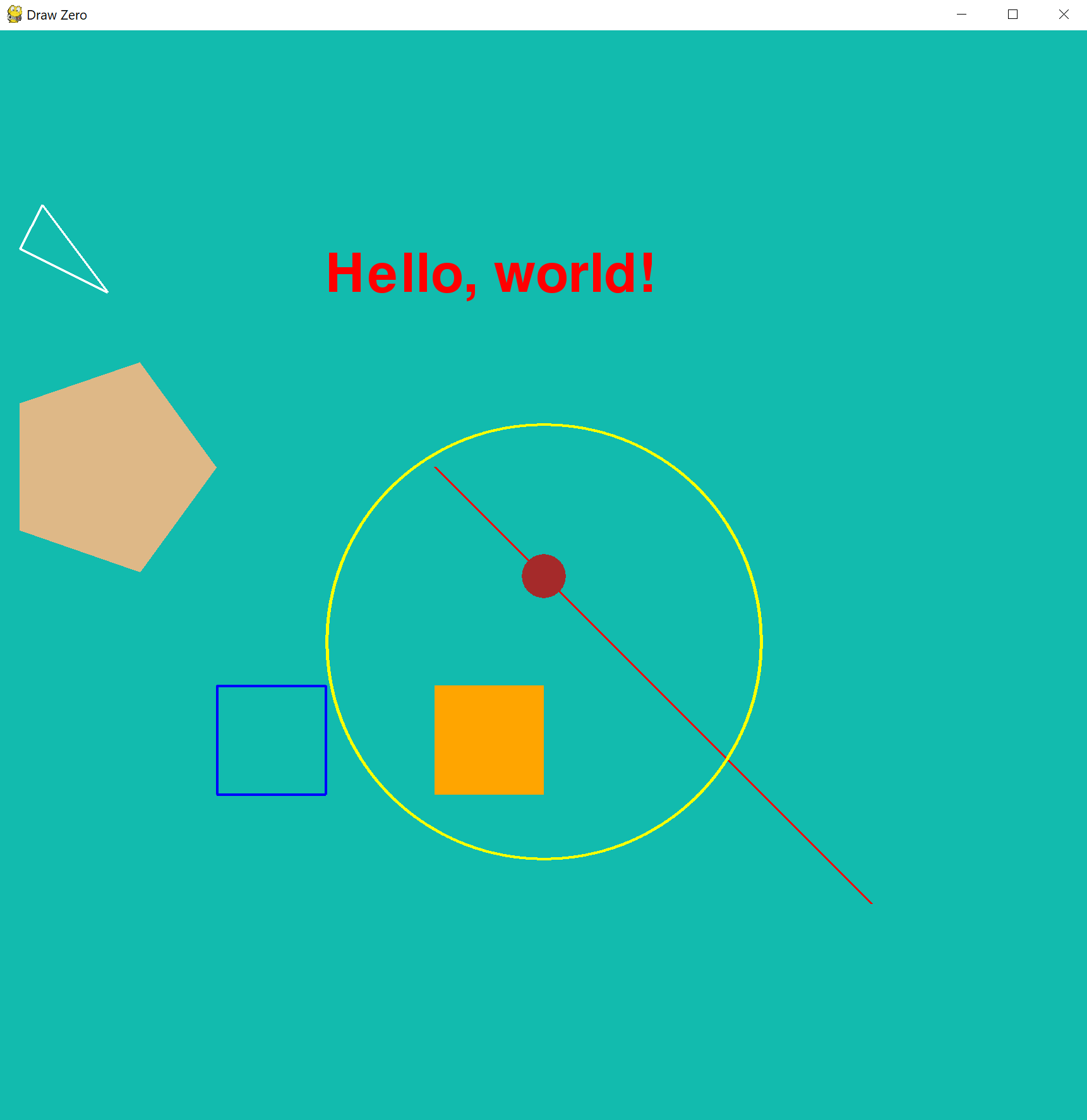
Animations are also straightforward:
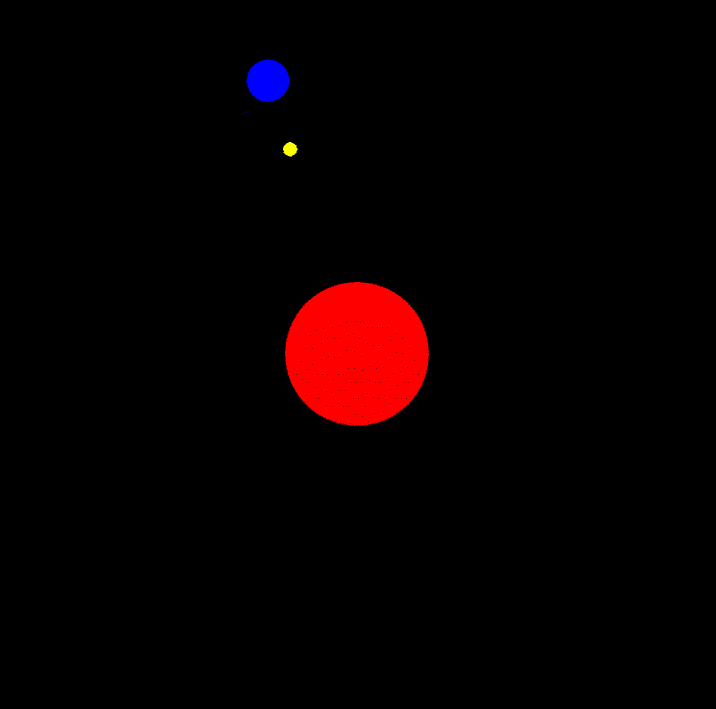
from drawzero import *
from math import sin, cos, pi
earth_orbit = 400
earth_radius = 30
earth_rot_step = 2 * pi / 360
moon_orbit = 100
moon_radius = 10
moon_rot_step = 2 * pi / 60
i = 0
while True:
i += 1
e_x = 500 + earth_orbit * cos(earth_rot_step * i)
e_y = 500 + earth_orbit * sin(earth_rot_step * i)
m_x = e_x + moon_orbit * cos(moon_rot_step * i)
m_y = e_y + moon_orbit * sin(moon_rot_step * i)
clear()
filled_circle(C.red, (500, 500), 100)
filled_circle(C.blue, (e_x, e_y), earth_radius)
filled_circle(C.yellow, (m_x, m_y), moon_radius)
tick()
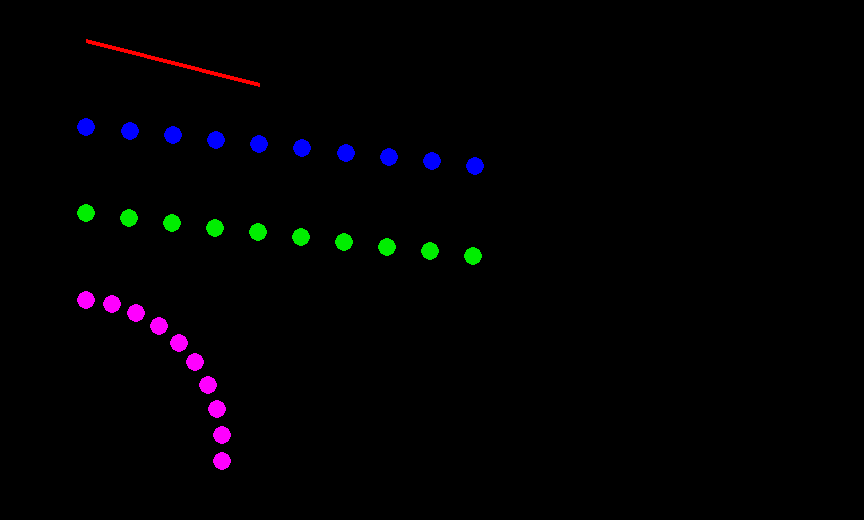
from drawzero import *
# just coordinates
A = Pt(100, 100)
B = Pt(300, 150)
line(C.red, A, B)
# A point which acts as 2-d vector and as a Turtle
# Pt(x=0.0, y=0.0, *, heading=0.0)
#
# Provides (for a, b — points, k number):
# * arithmetic
# a+b — vector addition
# a-b — vector subtraction
# k*a and a*k — multiplication with scalar
# abs — absolute value of a
# +a, -a
# arithmetic
A = Pt(100, 200)
dx = Pt(50, 5)
for i in range(10):
filled_circle(C.blue, A + dx * i, radius=10)
# * turtle-style movement
# forward — Move the point forward by the specified distance.
# backward — Move the point backward by distance.
# right — Turn point right by angle degrees.
# left — Turn point left by angle degrees.
# goto — Move point to an absolute position.
# rotate_around — Rotate around given point by angle degrees.
# move_towards — Move towards the given point by the specified distance.
# reset, home — Move point to the origin - coordinates (0,0), set heading=0
# setx — Set the point's first coordinate to x
# sety — Set the point's second coordinate to y
# setheading — Set the point's heading
A = Pt(100, 300)
B = Pt(1000, 400)
for i in range(10):
filled_circle(C.green2, A, radius=10)
A.move_towards(50, B)
A = Pt(100, 400)
for i in range(10):
filled_circle(C.magenta, A, radius=10)
A.left(10).forward(30)
# * information
# position — Return the point's current location (x,y), as a tuple.
# x, xcor — Return the point's x coordinate.
# y, ycor — Return the point's y coordinate
# heading — Return the point's heading
# distance — Return the distance between points
# towards — Return the angle towards point
# * deep copy
# copy — a clone of point
Transparency is also straightforward via alpha parameter or RGBA color:

from drawzero import *
clear()
fill(C.black)
filled_circle('red', (100, 100), 20)
filled_circle('blue', (100, 110), 22, alpha=100) # <-- alpha
circle('red', (100, 100), 50, line_width=10)
circle((0, 255, 0, 50), (100, 110), 50, line_width=10) # <-- RGBA
...
from drawzero import *
clear()
fill(C.black)
filled_circle('red', (100, 100), 20)
filled_circle('blue', (100, 110), 22, alpha=100)
circle('red', (100, 100), 50, line_width=10)
circle((0, 255, 0, 50), (100, 110), 50, line_width=10)
filled_rect(C.aquamarine, (200, 100), 100, 40)
filled_rect(C.darkmagenta, (210, 110), 100, 40, alpha=80)
rect(C.darkgoldenrod, (180, 90), 200, 80, line_width=10)
rect(C.hotpink, (190, 90), 200, 90, alpha=180, line_width=10)
line('red', 600, 400, 600, 990)
image('cat.png', (500, 500))
image('cat.png', (500, 800), width=200, alpha=128)
image('cat.png', (550, 850), width=200, alpha=128)
polygon('yellow', [(20, 300), (100, 340), (40, 260)], line_width=20)
polygon((0, 0, 255, 200), [(20, 300), (100, 340), (40, 260)], line_width=15)
polygon('red', [(20, 300), (100, 340), (40, 260)])
filled_polygon('burlywood', 200, 600, 130, 504, 20, 542, 20, 658, 130, 696)
filled_polygon(C.hotpink, 200, 700, 130, 604, 20, 642, 20, 758, 130, 796, alpha=100)
line(C.green, (700, 100), (800, 200))
line(C.green, (710, 100), (810, 200), line_width=5)
line(C.red, (820, 100), (720, 200), line_width=10, alpha=50)
line(C.blue, (830, 100), (730, 200), line_width=10, alpha=128)
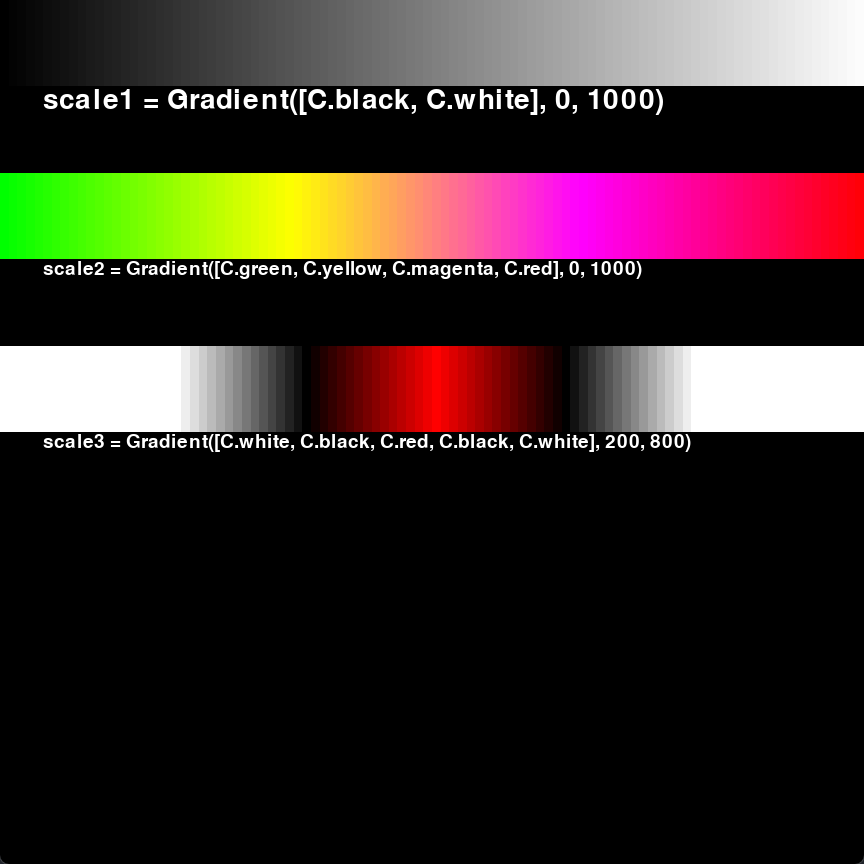
from drawzero import *
scale1 = Gradient([C.black, C.white], 0, 1000)
for x in range(0, 1000, 10):
filled_rect(scale1(x), (x, 0), 10, 100)
text(C.white, 'scale1 = Gradient([C.black, C.white], 0, 1000)', (50, 100), 48, '<^')
scale2 = Gradient([C.green, C.yellow, C.magenta, C.red], 0, 1000)
for x in range(0, 1000, 10):
filled_rect(scale2(x), (x, 200), 10, 100)
text(C.white, 'scale2 = Gradient([C.green, C.yellow, C.magenta, C.red], 0, 1000)', (50, 300), 32, '<^')
scale3 = Gradient([C.white, C.black, C.red, C.black, C.white], 200, 800)
for x in range(0, 1000, 10):
filled_rect(scale3(x), (x, 400), 10, 100)
text(C.white, 'scale3 = Gradient([C.white, C.black, C.red, C.black, C.white], 200, 800)', (50, 500), 32, '<^')
Process keyboard events in two ways: check if key is pressed via get_keys_pressed() or run throw keysdown or keysup events:
from drawzero import *
upper_text = 'Typed: '
SIZE = 20
x = y = 500 - SIZE // 2
while True:
# Mouse buttons events
if mousebuttonsdown:
x, y = mousebuttonsdown[0].pos
# Keys which are still pressed
keys = get_keys_pressed()
if keys[K.UP] or keys[K.w]:
y -= 5
if keys[K.DOWN] or keys[K.s]:
y += 5
if keys[K.LEFT] or keys[K.a]:
x -= 5
if keys[K.RIGHT] or keys[K.d]:
x += 5
# Keyboard events
for ev in keysdown:
if ev.unicode:
upper_text += ev.unicode
# Redraw everything
clear()
filled_rect(C.red, x, y, SIZE, SIZE)
text(C.white, upper_text, (100, 5))
filled_circle(C.yellow, mouse_pos(), 3)
tick()
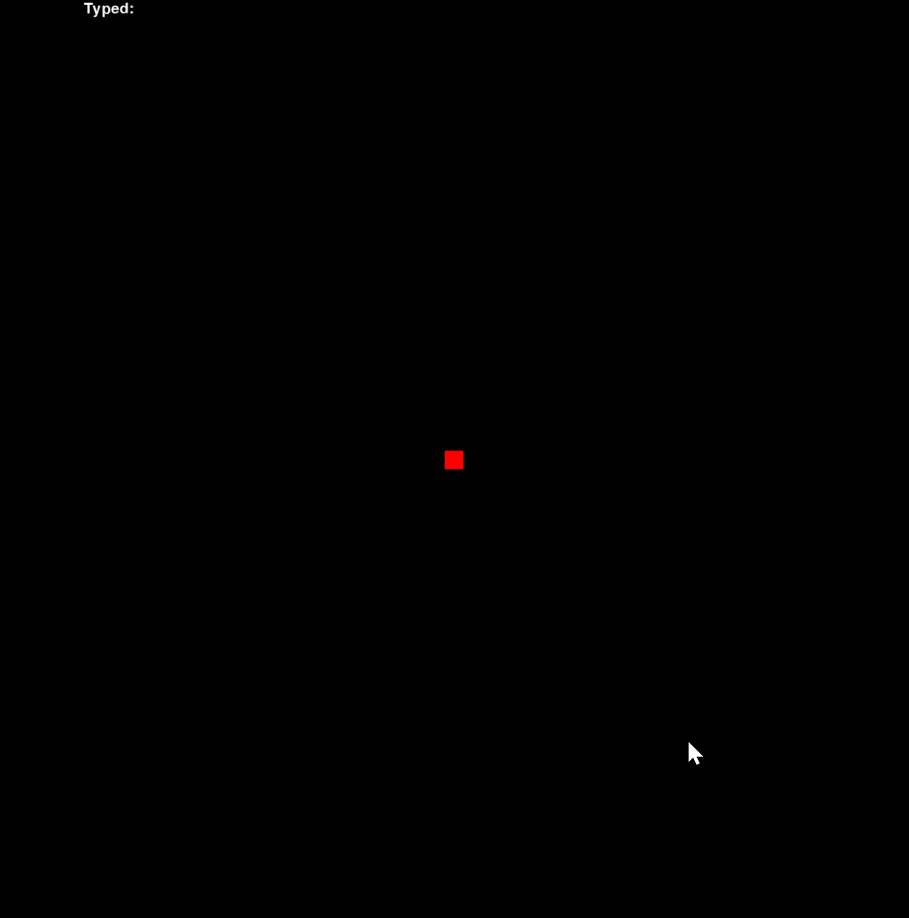
In a Terminal window, type:
pip install drawzero --upgrade --user
Or run the following program:
import os, sys
python = sys.executable
user = '--user' if 'venv' not in python and 'virtualenvs' not in python else ''
cmd = f'"{python}" -m pip install drawzero --upgrade {user}'
os.system(cmd)
from drawzero import *
FAQs
A zero-boilerplate canvas drawing framework for Python 3, based on Pygame.
We found that drawzero demonstrated a healthy version release cadence and project activity because the last version was released less than a year ago. It has 1 open source maintainer collaborating on the project.
Did you know?

Socket for GitHub automatically highlights issues in each pull request and monitors the health of all your open source dependencies. Discover the contents of your packages and block harmful activity before you install or update your dependencies.

Security News
Maven Central now validates Sigstore signatures, making it easier for developers to verify the provenance of Java packages.

Security News
CISOs are racing to adopt AI for cybersecurity, but hurdles in budgets and governance may leave some falling behind in the fight against cyber threats.

Research
Security News
Socket researchers uncovered a backdoored typosquat of BoltDB in the Go ecosystem, exploiting Go Module Proxy caching to persist undetected for years.